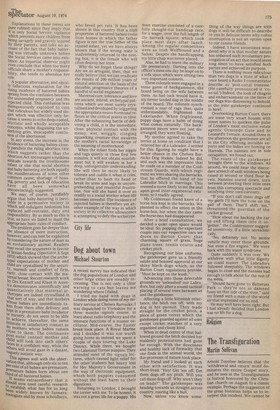The Transfiguration
Martin Sullivan
Arnold Toynbee believes that the 'withdrawal and return' motif dominates the entire Gospel story, and he sees in the Transfiguration (a festival honoured by the Christian church on August 6) a classic example. Perhaps the suggestion of the great historian helps us to interpret this incident. We cannot be sure what actually happened or whether we are reading sober history, but we would be very unwise to pass over the incident without reflection. It is a moment of revealed glory. The carpenter becomes King, but only His closest friends are given the privilege of witnessing the transfiguration. With Him also stand Moses and Elijah, archetypes of the Law and the Prophets whose message Jesus came to fulfil. And this high peak of glory is reached in an hour or two of withdrawal. Three Evangelists record the story; each adding or emphasising some points which he felt were important. So Luke characteristically tells us that Jesus went up to the hill to pray. In the wilderness and in the Garden of Gethsemane, two other climactic experiences in His life, He withdrew for exactly the same purpose. He faced the full onslaught of temptation in the first, and sweated in bloody agony in the second. What happened here? The writers tell us, in graphic language.
Although the actual report of the occasion is simply told, it is rich in symbolism. Christ takes His friends to the top of a high mountain and there a strange mysterious experience befell them. The appearance of His face changed and in keeping with this transformation, His garments shone with a brilliant whiteness. Two forms appeared alongside Him, recognisable as Moses and Elijah and seemed to be in conversation with Him. At that moment the impetuous Peter burst out with the request that this fleeting glimpse of past and present, and perhaps of the future, should not pass away. "It is good for us to be here," he said, "let us build three shelters." In other words, "let us remain for ever on the heights." While he was actually speaking a cloud overshadowed them, but no ordinary cloud. We are meant to understand that this was the Shekinah, the sign of God's glory. The sense of the numinous was deeply felt, "they were afraid as they entered it." And as at Christ's Baptism, so now at His Transfiguring, a voice was heard "This is my Son, My Chosen; listen to Him." And when the voice ceased Jesus was seen to be alone; alone now in His triumph, soon to be alone on His Cross. The scene fades and down the mountain .side they tramp, and there waiting for them was a poor demented boy whose father begged Jesus to heal him. Pointedly he told Christ that he had brought his son to the disciples, but they were powerless to do anything for him. These were the nine 'who had not scaled the mountain top'. Would the three who had just a short time before had a vision of the Kingdom, the Power and the Glory have done any better?
Whatever we may make of the story of the Transfiguration, we cannot escape its revealing truths. The itinerant Galilean is no ordinary man, neither was He a demigod, but there was about Him and within Him that quality which only the word Divine seems to explain. He is not the reporter of the Transfiguration; He offers no justification of Himself; His friends tell us of this tremendous experience and writing in shorthand leave us to fill in the narrative. But everything about Him finally is earthed. At one with the Patriarchs, surrounded by the cloud of glory, at one indeed with God Himself, He yet translates all this into human terms. He uses it all, for the relief of one unknown epileptic boy.
Were the disciples able to understand that in this act of healing they saw the Transfiguration re-enacted? Someone comes to a glorious act of worship in a great Cathedral, or finds the peace which passes understanding in a quiet communion service, and then goes home to a waiting helpless geriatric, an autistic child, or a mental defective. The Transfiguration must be known and felt and seen in the valley if the vision on the mountain is to be real.
Martin Sullivan is Dean of St Paul's.

































 Previous page
Previous page